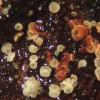
24-12-2025 17:08
Hulda Caroline HolteHello, I have found this propoloid ascomycete on

21-12-2025 09:32
Hello.A tiny ascomycete found embedded in wood in

21-12-2025 21:32
Pol DebaenstHello, Garden, Burgweg 19, Veurne, BelgiumOn 10/1

22-12-2025 23:38
Patrice TANCHAUDBonsoir, récolte sur un mur en pierre, apothéci

22-12-2025 00:47
Patrice TANCHAUDBonsoir, récolte à proximité du milieu dunaire
Calycina conorum
Yannick Mourgues,
01-02-2008 23:49
 Bonsoir.
Bonsoir.J'ai observé que Calycina conorum rougissait fortement à la blessure. Est-ce que l'un d'entre vous saurait pourquoi ? Quelle est la réaction chimique responsable de cela ?
I have watched that Calycina conorum becomes strongly reddening when hurted. Do you know why ? What is the chemical process ?
Merci par avance.
Yannick
Perz Piotr,
02-02-2008 09:39
Re:Calycina conorum
Hi Yannick
I thint this is oxidation of VBs i paraphyses, marginal- & excipulum cells.
Pimpek
I thint this is oxidation of VBs i paraphyses, marginal- & excipulum cells.
Pimpek
Hans-Otto Baral,
02-02-2008 11:38

Re:Calycina conorum
Yes, it is a wide-spread property in Helotiales and always the result of oxidation of refractive vacuoles. Typical of Lachnum, Bryoscyphus, some of Calycina etc. I think it has to do with benzol rings in which the double bindings change through oxidation and therefore get coloured. It is always a lethal process so that redbrown paraphysis or hair cells are never coloured as long as they are alive.
We have so important vital characters like VBs and we know so little about thier chemical background. It would be an interesting field of research for chemistry.
Zotto
We have so important vital characters like VBs and we know so little about thier chemical background. It would be an interesting field of research for chemistry.
Zotto
